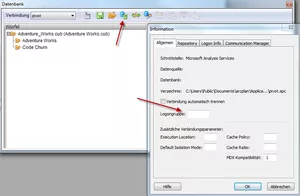As already described in the article Tips & Tricks: arcplan Background Report to connect to Databases, it frequently happens in arcplan reports that multiple databases are connected to the application. In the aforementioned article, an individual and very dynamic way of using the central starting page for log-in purposes was described; this makes these log-in processes as user-friendly as possible and affords the possibility to adjust these log-in processes to the corporate layout.
A user-friendly method: The logon group
An additional possibility is afforded by the property “Logon group” in the settings options of a connection file.
The logon group can be used to simultaneously log in to one or more databases via multiple connection files.
This setting of the logon group can be reached via the database window (select database) --> Info
A prerequisite is that the user name and the password are identical for all data connections. In order to activate the logon group, it is simply required to write the same number into the logon group field of multiple connections.
arcplan will then display the standard database login dialogue once and forward the entered login information to all data connections of the same logon group.
Unlike with the individual starting page, the login dialogue is displayed upon the first connection to one of the databases of the logon group. Thus, it is not necessarily ensured that the user has to log in immediately after starting the application. However, the dialogue may be enforced as early as on the starting page by means of a simple query against the database.
The use of the logon group is a great option if all connections can be combined in one logon group. If various login information exists for the same user and if many technical users are used for individual data connections, then the individual starting page is the more flexible solution. Here, all necessary data may then be queried on one page; multiple pop-ups are avoided.








